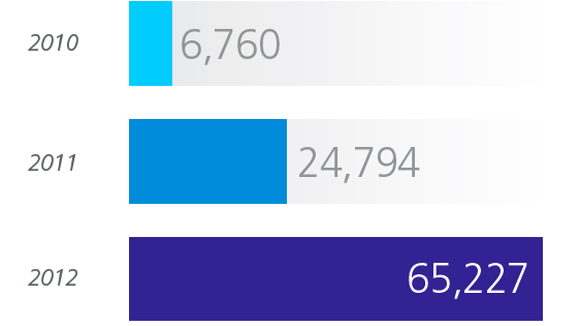Mobile malware jumped 163 percent in 2012, mostly on Android
Android malware made up 95 percent of the infected

Smartphones seem a little dumber today, falling victim to 163 percent more malware in 2012 than the previous year, according to a new report.
The NQ Mobile 2012 Security Report found that this was especially true for devices running the Android operating system, with nearly 95 percent of malware found on Google hardware.
That amounts to more than 32.8 million Android devices infected in 2012 when just 10.8 million were host to malware in 2011.
App Repackaging was the most common method used by malware authors, the report found, followed by malicious URLs and SMiSishing.
Mo' mobiles, mo' problems
Of course, Android does have a larger market share this year, with Google expecting to top one billion device activations by the end of 2013.
There were just 300 million as of early in 2012, TechCrunch points out.
Knowing this, it's hardly fair to compare it to a discontinued platform like Symbian, for example, which ended up with a 4 percent infection rate.
Get daily insight, inspiration and deals in your inbox
Sign up for breaking news, reviews, opinion, top tech deals, and more.
Malware by country
Another reason Android continues to be the most malware-targeted mobile OS is that it's more popular in pirate-heavy countries like China, India, and Russia.
Out of all malware-infected handsets scanned, 25.5 percent were in China, 19.4 percent were in India, and 17.9 percent were in Russia.
The U.S. and Saudi Arabia brought up the tail end of the five-country list, with 9.8 percent and 9.6 percent infection rates respectively.
While instances of malware infections did not significantly increase from 2011 to 2012 in the U.S., the market is an attractive target for cybercriminals," said NQ Mobile in its four-page report.
"NQ Mobile expects to see an increasing number of attacks on smartphones in the region."
Tips for avoiding mobile malware
NQ Mobile ended its report by offering a little advice for mobile device owners who are looking to reduce their chance of malware infection.
First, keeping on top of operating system updates is almost always a good idea.
"Two years after its introduction, more than 39 percent of Android users are still using Gingerbread," the report notes.
"As a result, these mobile consumers are lacking many of the major security updates provided by Ice Cream Sandwich and Jelly Bean."
With Apple's track record for botched iOS updates, iPhone and iPad owners are given a pass on this one.
The report also cautions the increasing trend of app sideloading outside of the Google Play store naivete youngers device owners.
"According to Nielsen 58% of children aged 13-17 in the United States own smartphones."
"This is a demographic that not only downloads more apps (41 on average) but is also more open to downloading content and apps outside of Google Play (46 percent)."
Basically, junior needs to stop downloading those "free" Android games that can collect sensitive data and aren't actually free in the end.
